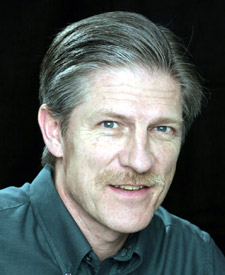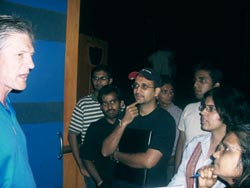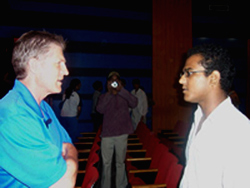 “The reason that Hollywood appeals to the rest of the world is because it has spent a lot of time trying to find common human emotions that everyone can relate to, I think I see that in the Indian artists as well”
“The reason that Hollywood appeals to the rest of the world is because it has spent a lot of time trying to find common human emotions that everyone can relate to, I think I see that in the Indian artists as well”
Besides being a prolific animation producer and director, the creator of the world’s first fully computer animated movie TRON as well as creator of FernGully… The Last Rainforest, one of the last cell animated movies, Animation Industry stalwart, Rhythm & Hues Sr Animation Director Bill Kroyer is also the member of the executive committee of the Academy of Motion Pictures Arts and Sciences, as well as the VES. Quite a few of his films have opened various Siggraph editions across the years….
Kroyer was in India for two weeks mentoring and interacting with the team at R&H India and while here, he also attended Anifest India 06 as well as gave an exclusive workshop open to all artists as part of the ASIFIA India CG Meetups where he had a lot of interaction with young Indian artists and students….
Within a span of a couple of months Animation ‘xpress Editor Anand Gurnani got a chance to interview the stalwart Kroyer twice. One was before his first visit to India and the other on the day he was returning back to LA.
The setting for the second interview was R&H India’s Malad studio, where in between supervising dailies, the key subjects that the veteran spoke about were the strengths and weaknesses he observed in Indian artists and what challenges they needed to overcome.
Excerpts…
In the past two weeks that you have been in India, you have interacted with a lot of Indian artists and students both from within R&H India and outside. What are your observations about them?
Everyone in the business of animation in India is young, very eager, and very anxious to learn. They are all very hard working and really smart with the ability to catch on fast and listen very carefully.
It’s going to be a fast growing industry here in India.
What other strengths do you see in Indian artists?
People here have a strong ability to pick up the tools. They understand computers which is a good thing.
The strength with the people here, or one of the advantages of the Indian artists as far as entertainment and working in animation is concerned, is that the Indian sensibility is very good from a world wide perspective. Their sense of entertainment, sense of humor and the habit of laughter is really good. It’s very much like ours, like the Americans.
I think the reason that Hollywood appeals to the rest of the world is because Hollywood has spent a lot of time trying to find common human emotions that everyone can relate to, I think I see that in the Indian artists as well. I see them relating to the same thing. That’s why I think that they have a chance to be successful making entertainment.
What weaknesses or what gaps do you see that need to be filled in the Indian animation space as such?
Well so far it’s just the lack of experience and really good projects that need to be worked on. There haven’t been a lot of really strong projects, with good budgets and good schedules done here in India, so most of the artists haven’t had a chance to work on really high quality projects and experience what that is like.
They haven’t really got many projects with a lot of good scenes and good shots to help them grow as artists…. So while that can’t be termed as a weakness, that’s the crucial difference or the gap. Indian artists need to get that exposure and experience.
Besides the rules that apply to film making in general, could you please elaborate a little on the essentials of animation film making and rules that students ought to keep in mind while making an animation film?
There is a saying that ‘Story is Character’.
All entertainment and movies start with a story and by extension it means that they have to have entertaining characters.
The difference with animation is that we create the characters and in a live action movie the character is acted by a real human being. In animation there is no reality, we have to create the design from scratch. The point is that the essential thing about entertainment which is ‘making believable characters’ is uniquely difficult in animation.
We have to make a character out of literally nothing and make the audience believe that the character thinks, feels, has emotions and has stories…
Any essentials that someone should follow, given your vast experience there must have been things that you’ve outlined as dos and don’ts?
Essential in animation is that you have to be aware of the fundamentals of animation, so that you can create a character that the audience will accept. If you are not skilled enough to create a character that that is balanced in weight and with good expressions, the audience will just not accept it. You have to be so good that the audience forgets that they are watching a created character and they start watching what the character is doing and how the character is thinking.
The first thing that animators have to do is to develop the skills to create a believable world. Only after they acquires those skills, do they get to the entertainment part of the thing.
 “You have to be so good that the audience forgets that they are watching a created character and they start watching what the character is doing and how the character is thinking.”
“You have to be so good that the audience forgets that they are watching a created character and they start watching what the character is doing and how the character is thinking.”
Please speak a little about the characters that have been your personal favorites in animation?
I just love Batty from Fern Gully…, he is so sympathetic. It is also fun creating comic characters, quirky characters. Creating heroes and heroines is more difficult because there is a broad outline to super-heroes as in they have to have some super strengths and so on. But one can really go imaginative and fun when it comes to the other characters.
There are a lot of characters that I love like all the little birds in the movie ‘For the Birds’. I really appreciated that film because there were only two character designs in the film the big bird and the little birds. All the little birds were identical. They were only distinguishable by their animated performance, every single one of them is a totally different personality in-spite of having the same character design. To me that was a terrific example of animation acting because it was completely about the motion and the performance.
The other favorites are all the charcaters from Finding Nemo, The Incredibles and Brad Bird’s other characters. He always has stories with wonderful characters such as The family which people can relate to, connect with and which seem original and genuine.
The character whose performance I look back on and which according to me has been the strongest film in animation history is Dumbo. I think that it is the simplest cartoon feature film ever made and the performance in that film is the most sympathetic performance ever done. The very fact that it was done in a very simple cartooning style proves that technology is irrelevant in making characters that we believe in and care about.
What do audiences go to watch, a medium or a story? Your comments on the 2D-3D topic
Audiences go to watch a story. But things like 2D-3D do crop up because animation is a business. The reason it’s successful and the reason people like it is because they love the art, but the reason it gets made is because it’s a business. The fact is that people are supplying the money and making decisions, they think first about the business part. They look at trends, they see that CG movies are doing well, are more reliable and are a better bet for your money so that’s what they are going to bet on. It’s much harder to make 2D films hence people avoid taking that risk. The 2D art form will of course stay alive in short films.
Another thing about 2D films is the incredible artistry involved. It’s so hard to do a 2D film because we need to support such a huge team of artists for such a long time.
Could you please tell us about the ratio of people that will be required for a 3D film as compared to 2D?
For a 3D film you could have a 150 to 200 people to create the entire film, while the total number of people required for a 2D film is close to 400.
You mentioned at the workshop that no 3D artist should start learning directly from 3D. Your comments on that…
2D is a great medium to learn and work with. It is the economics and logistics of a 2D feature film that are very difficult. For an artist to sit down with his drawing work and animate, 2D is the easiest thing in the world. To learn to do rough animations with a pencil and a paper and then scan is really easy to do and anybody can do so even from home. It’s a terrific way to learn the principles of animation. That’s why we encourage all the schools and institutes to offer their students, the opportunity to learn 2D animation.
Another thing that you mentioned at the ASIFA India workshop was that 2D as a medium, hones the artists faculty to visualize space, performance and motion much better than 3D does. Your comments
People working in 3D can develop a visual sense of perspective too but it is a little more difficult as compared to 2D animation. The other problem with most 3D artists is that because they already have a modeled character ready on screen, they get excited and get involved in moving the characters without taking a pause and visualizing the performance that they are to work on.
When you draw you have to think first. You have to visualize the transition and watch the difference between poses. In 3D it’s not quite the same.
Do you think making Tron when it was made, was a bigger challenge then doing a Garfield is today?
Considering the limitations in terms of tools and technology that we had then, I’d say it was more difficult to create Tron.
The studio where we created Tron had just two 80 megabytes hard drives. These were all that were used to process the rendered images which were all hand drawn;
Do you think the challenge is lesser or is there a newer set of challenges today?
Most of the challenges lie in making the imagery and the tools that make them. Now we have all the tools to do any kind of imagery or reality. The challenge lies in how to use the tools. An important aspect that always has to be remembered is the business and economics side. The tools and imagery should be used in such a way that they help generate income, help produce more and better for lesser. That’s really what it’s all about.
As a member of the executive committee of the Academy, could you please share with us some things about the Academy and the process of selecting the best animated feature?
It’s a simple process.
In order to submit the film and for it to be eligible to be considered for nomination, it has to either win a film festival or it could be played in a theater. Hence, with that as the criteria around 60 -70 films worldwide, that is short films, are eligible for the Oscars. These are submitted by the directors to the Academy.
Every one of those submitted films are screened by a large committee of volunteers within the Academy. That is followed by a vote. The top entries (that garner highest votes) go into the next phase where the general membership, all the members of the Academy can vote and then there’s auditing agencies like PWC that audit …. That’s what makes these Awards so coveted. The people who make the decisions are the most talented and experienced people in the field.
Some other awards like the Golden Globe may have journalists who may have their own perspectives but they can’t replace the actual professionals. In the Academy we have people who make the movies, and if they say that the movie is good then it probably is.
I’m on the Executive Committee of the Academy, which means that I’m an elected member of the committee that makes the rules. Sometimes the rules change. In recent years we have been adjusting rules to make them have room for digital submissions. Now it is possible to submit films with a digital format and we had to define the digital format. Some other things also come up like the Oscar for the best Animated Feature and then we have to explain what an animated feature film is.
The way we have defined an animated feature film is one in which the principal actors must be animated and animation must figure in 3/4ths of the running time of the film, these are the 2 predominant criteria.
Would Narnia be legible as an entry for best animated feature then?
No. In The Chronicles of Narnia, even though Aslan one of the principal characters is animated he is outnumbered by the rest of the principal characters most of which were human. The real people were in most of the scenes and because of that it’s not really an animated feature film.
A Few comments on SIGGRAPH.
It still is the biggest computer graphics convention globally, and is a big meeting place for professionals from all over the world to come together and network. It’s not as exclusive as it was in the younger days when it was smaller, back then everybody in the community knew one another. It was a small exclusive world but now with so many people doing computer graphics SIGGRAPH is huge with around 30000 people attending it, so there’s a different energy there. But the scale hasn’t diluted its quality and SIGGRAPH is still a valuable conference and digital entertainment has become really important. SIGGRAPH is significant for its scientific and technological importance.
Which other conferences and events would you recommend?
I don’t go to a lot of conferences…
A lot of people like to go to E3 which is currently underway. That’s a lot of fun if you’re a gamer. But animators would like to go to animation festivals like Annecy in France which is big, then there’s Hiroshima in Japan, the LA shorts festival etc.
The other things that are fun going to are the awards… in addition to the Academy Awards, I mean if you’re an animator, there’s the Annie Awards and the Visual Effects Society Awards. Because VFX is really our business so events like the VES Awards have become really fun events. They are fun because it’s the community, peers, like brothers and sisters in business and people you work with alongside all the time. Its real fun to go and see the work and be with them!
 “The job that will give you the best opportunity to become a better artist is the job that you should pursue. Because if you become better, the money will come”
“The job that will give you the best opportunity to become a better artist is the job that you should pursue. Because if you become better, the money will come”
Parting shots
I would say the biggest challenge to the Indian artists is going to be to try and improve their art. There will be a lot of pressure to work fast and on the budget because right now, what attracts people to India is that they are looking to get people to work at a good price. There’s nothing wrong with that because that’s what’s running the business and its development.
The challenge for the individual artist is to try and be a good animator, a good modeler, a good rigger. It’s going to be challenging to withstand that pressure and still do good work, and still be able to learn and to grow and expand. I think that’s the only way in which the individual can get better. And really at the end of the day it’s up to you to do that.You have to do it your self and you have to find the time to do it.
The temptation to go after the money in the beginning is going to always be there and there’s nothing wrong with earning money. But especially when you are young it’s really more important to be better and to prove yourself.
I used to tell young people, ‘A job that will allow you to grow the most is the job you should want. The job that will give you the best opportunity to become a better artist is the job that you should pursue. Because if you become better, the money will come.
But you have to become good.

